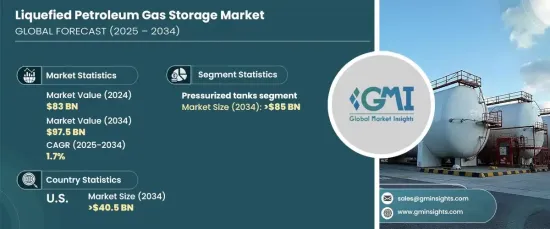 |
市场调查报告书
商品编码
1666949
液化石油气储存市场机会、成长动力、产业趋势分析及 2025 - 2034 年预测Liquefied Petroleum Gas Storage Market Opportunity, Growth Drivers, Industry Trend Analysis, and Forecast 2025 - 2034 |
||||||
2024 年全球液化石油气储存市场价值为 830 亿美元,预计 2025 年至 2034 年期间将以 1.7% 的复合年增长率稳步增长。随着世界各国政府推动扩大液化石油气的使用,已推出各种措施来提高其供应,进一步促进市场扩张。这些努力以及人们对环境永续性的日益关注,大大推动了液化石油气储存市场的发展。

此外,政府正在执行更严格的法规和安全协议,从而导致对更先进的液化石油气储存解决方案的投资。政府和私营部门都在投资最先进的储存技术,整合洩漏检测系统和压力监测等安全功能,从而进一步加强市场。人们对能源效率、安全性和永续性的日益关注,正在促进旨在满足日益增长的液化石油气需求的创新储存技术的发展。
| 市场范围 | |
|---|---|
| 起始年份 | 2024 |
| 预测年份 | 2025-2034 |
| 起始值 | 830亿美元 |
| 预测值 | 975亿美元 |
| 复合年增长率 | 1.7% |
预计到 2034 年,压力罐市场的规模将超过 850 亿美元。加压罐能够在紧凑的空间内有效地容纳大量液化石油气,非常适合住宅和工业用途。它们的适应性,加上改进的耐腐蚀材料、绝缘和整合监控系统等新技术,将在未来几年推动这一领域的成长。
在美国,到2034年液化石油气储存市场规模预计将超过405亿美元。此外,向更清洁能源的转变扩大了液化石油气在住宅烹饪、暖气和工业领域的使用,从而增强了储存和分配系统。智慧监控和自动化系统在提高液化石油气储存的营运效率和安全性方面发挥重要作用。
政府为促进清洁能源和减少温室气体排放而实施的激励措施、强制措施和政策持续影响市场。这些法规提供了额外的成长机会,进一步支持了各地区液化石油气储存基础设施的发展。
目录
第 1 章:方法论与范围
- 市场定义
- 基础估算与计算
- 预测计算
- 资料来源
- 基本的
- 次要
- 有薪资的
- 民众
第 2 章:执行摘要
第 3 章:产业洞察
- 产业生态系统分析
- 监管格局
- 产业衝击力
- 成长动力
- 产业陷阱与挑战
- 成长潜力分析
- 波特的分析
- 供应商的议价能力
- 买家的议价能力
- 新进入者的威胁
- 替代品的威胁
- PESTEL 分析
第四章:竞争格局
- 介绍
- 战略仪表板
- 创新与永续发展格局
第 5 章:市场规模及预测:依储存类型,2021 – 2034 年
- 主要趋势
- 加压罐
- 冷藏罐
第六章:市场规模及预测:按地区,2021 – 2034 年
- 主要趋势
- 北美洲
- 我们
- 加拿大
- 欧洲
- 西班牙
- 俄罗斯
- 英国
- 义大利
- 法国
- 德国
- 亚太地区
- 中国
- 日本
- 韩国
- 印度
- 澳洲
- 中东和非洲
- 沙乌地阿拉伯
- 阿联酋
- 土耳其
- 南非
- 摩洛哥
- 拉丁美洲
- 巴西
- 墨西哥
- 阿根廷
第七章:公司简介
- AmeriGas
- China Petroleum
- CIMC ENRIC
- CLW Group
- Emirates Gas
- Energy Transfer
- Flogas
- Modern Welding
- Omera
- Oiltanking
- Pertamina
- Petredec
- Royal Vopak
- TotalEnergies
- TransTech Energy
- Vitol
The Global Liquefied Petroleum Gas Storage Market was valued at USD 83 billion in 2024 and is expected to grow steadily at a CAGR of 1.7% from 2025 to 2034. Rapid urbanization and the increasing demand for clean, efficient fuel alternatives to minimize environmental impact are key drivers propelling the market forward. As governments worldwide push for broader access to LPG, various initiatives have been introduced to enhance its availability, further boosting market expansion. These efforts, along with rising concerns over environmental sustainability, have given a significant push to the LPG storage market.

Additionally, governments are enforcing stricter regulations and safety protocols, leading to investments in more advanced LPG storage solutions. Both government and private sectors are investing in state-of-the-art storage technologies, integrating safety features such as leak detection systems and pressure monitoring, which further strengthens the market. The growing focus on energy efficiency, safety, and sustainability is fostering the development of innovative storage technologies designed to meet the growing demand for LPG.
| Market Scope | |
|---|---|
| Start Year | 2024 |
| Forecast Year | 2025-2034 |
| Start Value | $83 Billion |
| Forecast Value | $97.5 Billion |
| CAGR | 1.7% |
The pressurized tanks segment is predicted to surpass USD 85 billion by 2034. These tanks play a crucial role in the safe storage and distribution of LPG, as they maintain the gas in its liquid state under pressure, offering high energy density and efficient transport options. Pressurized tanks are highly effective in holding large quantities of LPG in compact spaces, making them ideal for both residential and industrial use. Their adaptability, combined with new technologies such as improved corrosion-resistant materials, insulation, and integrated monitoring systems, will drive the growth of this segment in the coming years.
In the United States, the LPG storage market is projected to exceed USD 40.5 billion by 2034. The country's abundance of shale gas, coupled with a rising demand for LPG driven by population growth and higher energy consumption, is fostering increased LPG production. Moreover, the shift toward cleaner energy sources has expanded the use of LPG across residential cooking, heating, and industrial sectors, leading to enhanced storage and distribution systems. Smart monitoring and automation systems are playing an essential role in improving operational efficiency and safety in LPG storage.
The implementation of government incentives, mandates, and policies promoting cleaner energy and reducing greenhouse gas emissions continues to shape the market. These regulations are providing additional opportunities for growth, further supporting the development of LPG storage infrastructure across various regions.
Table of Contents
Chapter 1 Methodology & Scope
- 1.1 Market definitions
- 1.2 Base estimates & calculations
- 1.3 Forecast calculation
- 1.4 Data sources
- 1.4.1 Primary
- 1.4.2 Secondary
- 1.4.2.1 Paid
- 1.4.2.2 Public
Chapter 2 Executive Summary
- 2.1 Industry synopsis, 2021 - 2034
Chapter 3 Industry Insights
- 3.1 Industry ecosystem analysis
- 3.2 Regulatory landscape
- 3.3 Industry impact forces
- 3.3.1 Growth drivers
- 3.3.2 Industry pitfalls & challenges
- 3.4 Growth potential analysis
- 3.5 Porter's analysis
- 3.5.1 Bargaining power of suppliers
- 3.5.2 Bargaining power of buyers
- 3.5.3 Threat of new entrants
- 3.5.4 Threat of substitutes
- 3.6 PESTEL analysis
Chapter 4 Competitive Landscape, 2024
- 4.1 Introduction
- 4.2 Strategic dashboard
- 4.3 Innovation & sustainability landscape
Chapter 5 Market Size and Forecast, By Storage Type, 2021 – 2034 (USD Billion, Million Barrels)
- 5.1 Key trends
- 5.2 Pressurized tanks
- 5.3 Refrigerated tanks
Chapter 6 Market Size and Forecast, By Region, 2021 – 2034 (USD Billion, Million Barrels)
- 6.1 Key trends
- 6.2 North America
- 6.2.1 U.S.
- 6.2.2 Canada
- 6.3 Europe
- 6.3.1 Spain
- 6.3.2 Russia
- 6.3.3 UK
- 6.3.4 Italy
- 6.3.5 France
- 6.3.6 Germany
- 6.4 Asia Pacific
- 6.4.1 China
- 6.4.2 Japan
- 6.4.3 South Korea
- 6.4.4 India
- 6.4.5 Australia
- 6.5 Middle East & Africa
- 6.5.1 Saudi Arabia
- 6.5.2 UAE
- 6.5.3 Turkey
- 6.5.4 South Africa
- 6.5.5 Morocco
- 6.6 Latin America
- 6.6.1 Brazil
- 6.6.2 Mexico
- 6.6.3 Argentina
Chapter 7 Company Profiles
- 7.1 AmeriGas
- 7.2 China Petroleum
- 7.3 CIMC ENRIC
- 7.4 CLW Group
- 7.5 Emirates Gas
- 7.6 Energy Transfer
- 7.7 Flogas
- 7.8 Modern Welding
- 7.9 Omera
- 7.10 Oiltanking
- 7.11 Pertamina
- 7.12 Petredec
- 7.13 Royal Vopak
- 7.14 TotalEnergies
- 7.15 TransTech Energy
- 7.16 Vitol












